★★★★
“The Family That Slays Together, Stays Together…”
 I’ve literally sprinted through from the living-room, where the two-hour season finale has just finished, leaving an aching void in our Sunday evenings that will remain until the third season starts in the fall. It was hard to see how the second series could live up to the first but, with a few relatively minor misgivings, it’s safe to say that the show has.
I’ve literally sprinted through from the living-room, where the two-hour season finale has just finished, leaving an aching void in our Sunday evenings that will remain until the third season starts in the fall. It was hard to see how the second series could live up to the first but, with a few relatively minor misgivings, it’s safe to say that the show has.
 Would have to admit that the start was somewhat slow. It was hardly a surprise to discover that most of the characters who were “dead” at the end of the first series made a miraculous comeback in the second. It’s exactly the sort of thing you expect from shows like this, and you wonder why they even bother. Indeed, much of the first half of the series was too predictable, revolving around the can-or-can’t Sydney trust her mother dilemma. No prizes for guessing the right answer there either.
Would have to admit that the start was somewhat slow. It was hardly a surprise to discover that most of the characters who were “dead” at the end of the first series made a miraculous comeback in the second. It’s exactly the sort of thing you expect from shows like this, and you wonder why they even bother. Indeed, much of the first half of the series was too predictable, revolving around the can-or-can’t Sydney trust her mother dilemma. No prizes for guessing the right answer there either.
The recovery began when ABC handed Alias the coveted post-Superbowl slot (though once the score in the game reached 34-3, its impact on ratings for Alias became doubtful). Still, it proved a pivotal episode, giving Abrams a chance to reinvent the show, and introduce it to a whole new audience too lazy to change the channel (due to overconsumption of beer and nachos, probably). This was apparent in some rather clunky back-exposition, and also an opening which featured Sydney in two sets of lingerie – a shameless, gratuitous piece of shallow exploitation, clearly designed to appeal to nobody but the gridiron fans. :-) They probably mistook it for another Victoria’ Secret commercial…
Luckily, there was a lot of actual content, too: The CIA moved in to take SD-6 down, and from then on, no longer was Sydney struggling to maintain her secret lives. The show would become a quest for Sloane, trying to stop him before he…well, no-one was quite sure what he was up to, but it never seemed likely to involve puppies and flowers. This episode also marked the start of an increasing body-count with one character murdered and replaced by an evil doppelganger, while later on, two spouses would also bite the dust.
With the Rambaldi story making a welcome reappearance, the season picked up steam, helped by cool guest stars: Rutger Hauer, Danny Trejo & David Carradine (a Buddhist monk!) – we just needed Udo Kier and we’d have been in cult heaven. Apparently lost in the duplicitous double-crossing was the action element, a disappointing facet. For example, not until the last 10 minutes of the two-hour season finale did Sydney get in some serious butt-kicking; we wondered if this was connected with Garner’s apparent weight gain. Too much comfort ice-cream after her recent break-up? Perhaps; though if she’s pregnant, you heard it here first.
 With so many threads too, the story arcs seemed disjointed: in some cases, you’d go for weeks without hearing anything, before an abrupt reappearance. However, a continuing strength was the development of the supporting cast, with Sloane switching from evil mastermind to sympathetic antihero, even within the course of a single episode. Dixon, too, enjoyed a spectacular character arc over the second half, going from committed SD-6 employee to a borderline psychopath, whose obsession with catching Sloane surpassed even Sydney’s.
With so many threads too, the story arcs seemed disjointed: in some cases, you’d go for weeks without hearing anything, before an abrupt reappearance. However, a continuing strength was the development of the supporting cast, with Sloane switching from evil mastermind to sympathetic antihero, even within the course of a single episode. Dixon, too, enjoyed a spectacular character arc over the second half, going from committed SD-6 employee to a borderline psychopath, whose obsession with catching Sloane surpassed even Sydney’s.
Our favourite episode of the season had beloved uber-geek Marshall going on a mission to London with Sydney. It combined action, humour, drama and pathos to great effect, ending with one of the best cliffhangers the series has yet managed – admittedly, we speak as big Marshall fans, and look forward to the character receiving a spinoff series. Hey, if it can happen to a mopey vampire, anything’s possible.
Fortunately, the Vaughn/Bristow romantic angle that begin to lurk, iceberg-like, towards the end of season one, has been played subtly enough that we are mostly able to ignore it. More remarkably, the Will/Francie relationship managed to become a genuine plot thread, thanks to a startling twist which raised the hairs on the back of our necks every time they shared a scene. Let’s just say that Francie isn’t the woman she used to be. :-)
Despite ratings that generally remain disappointing – it ranked only 92nd in prime-time shows – Alias was still renewed, a decision for which ABC can only be commended. However, they still seem uncertain about how to promote the show. Here we are, two seasons down, still waiting for the first to arrive on DVD – they could learn a lot from Fox, which got a huge boost to the ratings for the second run of 24 from the first’s availability on disc. [By coincidence, both Alias Season 1, and 24 Season 2 are scheduled for DVD release on September 2nd, 2003]
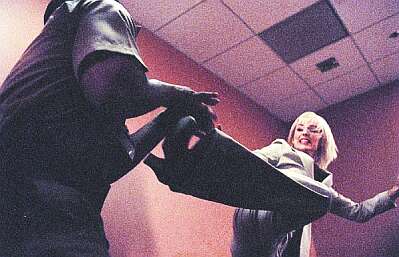 So where do we go in Series 3? We still have the Rambaldi machine; assembly now complete, but expect further machinations as they piece together the instruction manual, and discover they need a 240/110V convertor. :-) It looked for a moment like we would be missing one major character (who finally Got The Point), but sounds like he’s okay. However, the main thread appears to be Sydney, and her efforts to recover from what could simply be the mother of all hangovers – I mean, I sometimes wondered how I got home, but at least I usually woke up on the same continent. Funnily enough, I suspect there might be rather more to her blackout than one too many Babychams. The truth probably lies somewhere between that, and abduction by aliens, but we’ll have to wait until autumn to find out.
So where do we go in Series 3? We still have the Rambaldi machine; assembly now complete, but expect further machinations as they piece together the instruction manual, and discover they need a 240/110V convertor. :-) It looked for a moment like we would be missing one major character (who finally Got The Point), but sounds like he’s okay. However, the main thread appears to be Sydney, and her efforts to recover from what could simply be the mother of all hangovers – I mean, I sometimes wondered how I got home, but at least I usually woke up on the same continent. Funnily enough, I suspect there might be rather more to her blackout than one too many Babychams. The truth probably lies somewhere between that, and abduction by aliens, but we’ll have to wait until autumn to find out.
Star: Jennifer Garner, Victor Garber, Michael Vartan, Ron Rifkin

 The real strength of Bad Girls is the almost limitless possibilities of the scenario; if ever things are in danger of getting stale, it’s easy to lob in fresh characters to get the pot stirred up and create whatever angles you want. Exhibit A: new governor, Neil Grayling (Gadds), whose arrival gave the show a whole new direction, at least among the staff – and particularly Jim Fenner, who discovered a whole new viewpoint of sexual harassment. Not that it really made him see the error of his ways, of course.
The real strength of Bad Girls is the almost limitless possibilities of the scenario; if ever things are in danger of getting stale, it’s easy to lob in fresh characters to get the pot stirred up and create whatever angles you want. Exhibit A: new governor, Neil Grayling (Gadds), whose arrival gave the show a whole new direction, at least among the staff – and particularly Jim Fenner, who discovered a whole new viewpoint of sexual harassment. Not that it really made him see the error of his ways, of course.




 Poor Alias. Shunted from its Sunday slot to make way for Desperate Housewives – which proved successful beyond SD-6’s wildest dreams – this season felt as if JJ Abrams was more devoted to his second child, Lost (again, the owner of bigger ratings). By the end of the season it was Sydney, Jack, and their associates who found themselves both lost and somewhat desperate in TV-land, despite much-improved viewing figures – largely a result of following Lost, which got about 30% more audience.
Poor Alias. Shunted from its Sunday slot to make way for Desperate Housewives – which proved successful beyond SD-6’s wildest dreams – this season felt as if JJ Abrams was more devoted to his second child, Lost (again, the owner of bigger ratings). By the end of the season it was Sydney, Jack, and their associates who found themselves both lost and somewhat desperate in TV-land, despite much-improved viewing figures – largely a result of following Lost, which got about 30% more audience.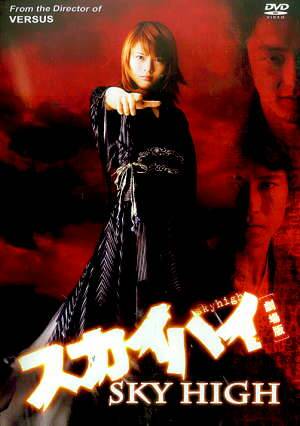 Combining elements from Dead Like Me and Ghost, this still manages to come up with something unique, especially given its origins as a prequel to a popular TV series. It is designed to explain how Mina (Shaku) got the job as Keeper of the Gate, where murder victims must decide whether to forgo revenge and pass on, return to Earth as a ghost, or seek vengeance at the price of eternal torment. She ends up there after having her heart torn out on her wedding day by insane billionaire serial killer Kudo (Osawa) who will stop at nothing to save his one true love, currently lying in a coma. Trust me – it all makes perfect sense, and it’s a particularly nice touch that Mina’s fiance, Detective Kohei (Shosuke) is equally driven in his actions by love.
Combining elements from Dead Like Me and Ghost, this still manages to come up with something unique, especially given its origins as a prequel to a popular TV series. It is designed to explain how Mina (Shaku) got the job as Keeper of the Gate, where murder victims must decide whether to forgo revenge and pass on, return to Earth as a ghost, or seek vengeance at the price of eternal torment. She ends up there after having her heart torn out on her wedding day by insane billionaire serial killer Kudo (Osawa) who will stop at nothing to save his one true love, currently lying in a coma. Trust me – it all makes perfect sense, and it’s a particularly nice touch that Mina’s fiance, Detective Kohei (Shosuke) is equally driven in his actions by love.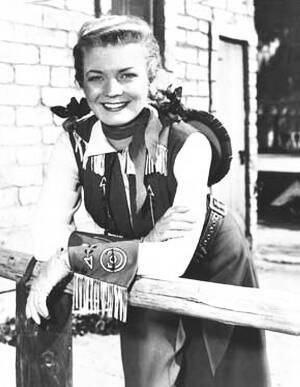 This TV series was Gene Autry’s idea; he wanted to give little girls a western star of their own, and created a show based on the character of Oakley, the most famous sharpshooter of all time. In his version, she lives in Diablo with her brother Tagg (Hawkins) and keeps the town safe along with deputy Lofty Craig (Johnson) – the sheriff, Annie’s uncle Luke, was somehow very rarely around… It ran for 81 episodes from January 1954 to February 1957; two DVDs, with five first season stories on each, have been released by Platinum – you can get the box set of both for $5.99, which is a steal.
This TV series was Gene Autry’s idea; he wanted to give little girls a western star of their own, and created a show based on the character of Oakley, the most famous sharpshooter of all time. In his version, she lives in Diablo with her brother Tagg (Hawkins) and keeps the town safe along with deputy Lofty Craig (Johnson) – the sheriff, Annie’s uncle Luke, was somehow very rarely around… It ran for 81 episodes from January 1954 to February 1957; two DVDs, with five first season stories on each, have been released by Platinum – you can get the box set of both for $5.99, which is a steal.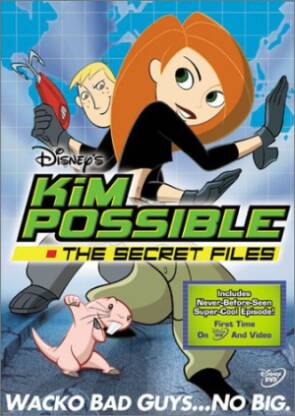 This compilation puts together four episodes – three from the first season, plus another at the time exclusive to the DVD. It’s hard to see who this is aimed at: if you’ve not seen the series, novices may find elements, such as Ron’s naked mole rat, kinda bizarre (trivia note: the rat’s squeaks are by Nancy Cartwright, who also does some loser called Bart Simpson). On the other hand, fans will have seen almost all the material, and would likely far rather have seen a complete Box Set rather than semi-random episodes. They’re not even particularly highly-regarded ones: the
This compilation puts together four episodes – three from the first season, plus another at the time exclusive to the DVD. It’s hard to see who this is aimed at: if you’ve not seen the series, novices may find elements, such as Ron’s naked mole rat, kinda bizarre (trivia note: the rat’s squeaks are by Nancy Cartwright, who also does some loser called Bart Simpson). On the other hand, fans will have seen almost all the material, and would likely far rather have seen a complete Box Set rather than semi-random episodes. They’re not even particularly highly-regarded ones: the 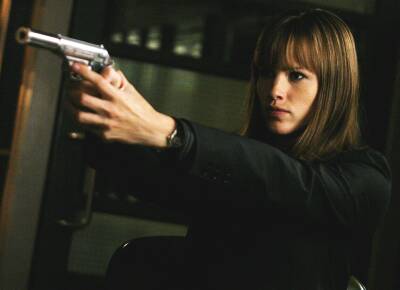 Where is Sydney, and what have you done with her? We might have been forgiven for uttering this cry at the end of season three, which exited not with a bang, but a whimper. “We need to talk.” That’s pretty much what Jack said to Sydney after she discovered, apparently, that her entire life had been a CIA operation. This was hardly a surprise, if you remembered Project Christmas from earlier on, Jack’s plan which tested first-graders – including his own daughter – for spyworthy attributes. The news that the show wouldn’t restart until January 2005 thus provoked little more than mild disappointment.
Where is Sydney, and what have you done with her? We might have been forgiven for uttering this cry at the end of season three, which exited not with a bang, but a whimper. “We need to talk.” That’s pretty much what Jack said to Sydney after she discovered, apparently, that her entire life had been a CIA operation. This was hardly a surprise, if you remembered Project Christmas from earlier on, Jack’s plan which tested first-graders – including his own daughter – for spyworthy attributes. The news that the show wouldn’t restart until January 2005 thus provoked little more than mild disappointment.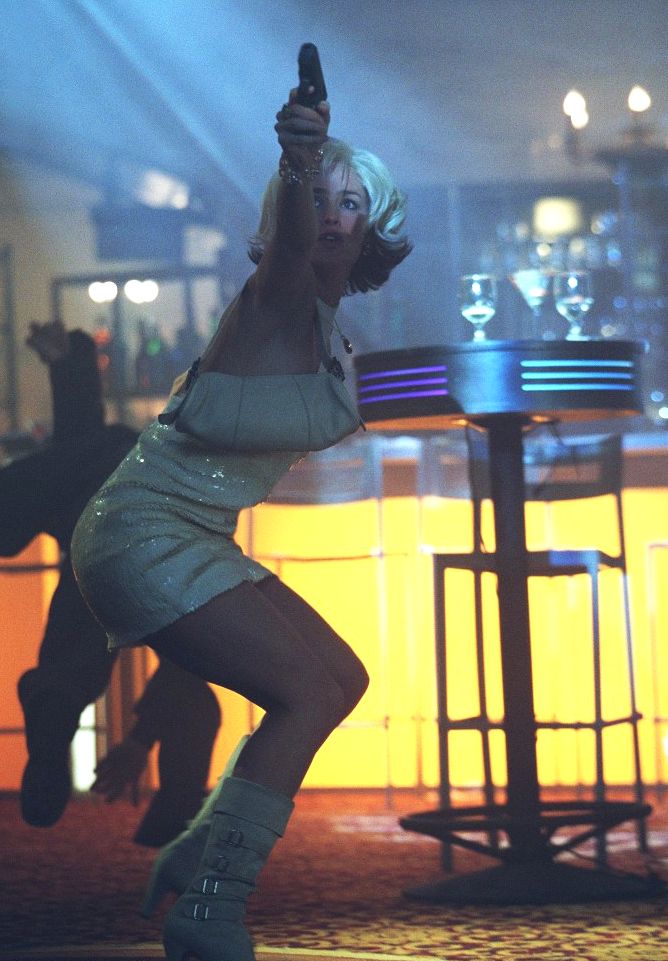
 The third series hit the ground running, Michelle Dockley taking evil warder Jim Fenner hostage, after stabbing him in the stomach with a broken bottle (to loud cheers here), and Nikki Wade breaking
The third series hit the ground running, Michelle Dockley taking evil warder Jim Fenner hostage, after stabbing him in the stomach with a broken bottle (to loud cheers here), and Nikki Wade breaking 
 With so many threads too, the story arcs seemed disjointed: in some cases, you’d go for weeks without hearing anything, before an abrupt reappearance. However, a continuing strength was the development of the supporting cast, with Sloane switching from evil mastermind to sympathetic antihero, even within the course of a single episode. Dixon, too, enjoyed a spectacular character arc over the second half, going from committed SD-6 employee to a borderline psychopath, whose obsession with catching Sloane surpassed even Sydney’s.
With so many threads too, the story arcs seemed disjointed: in some cases, you’d go for weeks without hearing anything, before an abrupt reappearance. However, a continuing strength was the development of the supporting cast, with Sloane switching from evil mastermind to sympathetic antihero, even within the course of a single episode. Dixon, too, enjoyed a spectacular character arc over the second half, going from committed SD-6 employee to a borderline psychopath, whose obsession with catching Sloane surpassed even Sydney’s. So where do we go in Series 3? We still have the Rambaldi machine; assembly now complete, but expect further machinations as they piece together the instruction manual, and discover they need a 240/110V convertor. :-) It looked for a moment like we would be missing one major character (who finally Got The Point), but sounds like he’s okay. However, the main thread appears to be Sydney, and her efforts to recover from what could simply be the mother of all hangovers – I mean, I sometimes wondered how I got home, but at least I usually woke up on the same
So where do we go in Series 3? We still have the Rambaldi machine; assembly now complete, but expect further machinations as they piece together the instruction manual, and discover they need a 240/110V convertor. :-) It looked for a moment like we would be missing one major character (who finally Got The Point), but sounds like he’s okay. However, the main thread appears to be Sydney, and her efforts to recover from what could simply be the mother of all hangovers – I mean, I sometimes wondered how I got home, but at least I usually woke up on the same 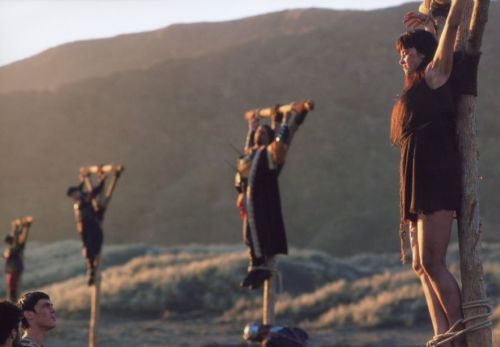 The defining moment of Xena’s sophomore season didn’t take place in any episode. In fact, it didn’t even take place in New Zealand, but thousands of miles away, During a rehearsal for an appearance on The Tonight show with Jay Leno, Lucy Lawless was thrown off a horse after it lost its footing, and broke her pelvis. It’s interesting to compare the reaction of the producers to what the Tapert/Raimi team did when the star of Spartacus, Andy Whitfield, was similarly a victim of severe misfortune, more than a decade later. There, they put the show entirely on hold and opted instead to film a prequel without him.
The defining moment of Xena’s sophomore season didn’t take place in any episode. In fact, it didn’t even take place in New Zealand, but thousands of miles away, During a rehearsal for an appearance on The Tonight show with Jay Leno, Lucy Lawless was thrown off a horse after it lost its footing, and broke her pelvis. It’s interesting to compare the reaction of the producers to what the Tapert/Raimi team did when the star of Spartacus, Andy Whitfield, was similarly a victim of severe misfortune, more than a decade later. There, they put the show entirely on hold and opted instead to film a prequel without him. In terms of style and approach, the show covers even more ground here than the first time, from absolutely froth to grim darkness. Xena even gets crucified by Julius Caesar in one episode [confusingly, the actor responsible also crops up later, playing Cupid, complete with fluffy wings…]. I’m sure I’m not the only one who found themselves whistling Always Look on the Bright Side of Life, during the scene shown above right. Another unwitting Python reference is the wretched Here She Comss, Miss Amphipolis, a dreadful tale of drag-queen empowerment, featuring perhaps the least convincing female impersonator since John Cleese put on a dress – as on the left, watch that Adam’s apple
In terms of style and approach, the show covers even more ground here than the first time, from absolutely froth to grim darkness. Xena even gets crucified by Julius Caesar in one episode [confusingly, the actor responsible also crops up later, playing Cupid, complete with fluffy wings…]. I’m sure I’m not the only one who found themselves whistling Always Look on the Bright Side of Life, during the scene shown above right. Another unwitting Python reference is the wretched Here She Comss, Miss Amphipolis, a dreadful tale of drag-queen empowerment, featuring perhaps the least convincing female impersonator since John Cleese put on a dress – as on the left, watch that Adam’s apple  It’s assumed viewers are at least somewhat familiar with Xena’s background, as she is first seen burying her armour in an effort to bury her past. Of course, this is about as successful as it usually is in fiction, and it’s not long before she’s saving villagers, including Gabrielle, from slavery. That includes an aerial battle atop platforms, which is the first sign of the show’s strong influence from Hong Kong action films; it was using wirework, in a way that predated its popular arrival in Hollywood. Similarly, the stunning New Zealand locations foreshadow Lord of the Rings, to the extent that I kept expecting to see hobbits gamboling along in Xena’s wake.
It’s assumed viewers are at least somewhat familiar with Xena’s background, as she is first seen burying her armour in an effort to bury her past. Of course, this is about as successful as it usually is in fiction, and it’s not long before she’s saving villagers, including Gabrielle, from slavery. That includes an aerial battle atop platforms, which is the first sign of the show’s strong influence from Hong Kong action films; it was using wirework, in a way that predated its popular arrival in Hollywood. Similarly, the stunning New Zealand locations foreshadow Lord of the Rings, to the extent that I kept expecting to see hobbits gamboling along in Xena’s wake.